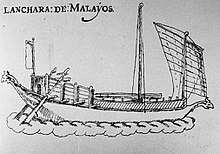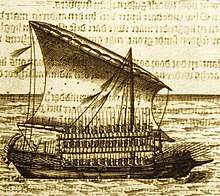Lancaran (ship)

A Lancaran is a type of sailing ship used in the Nusantaran archipelago. Although similar in shape to Mediterranean galleys, lancaran was the backbone of the regional fleet before Mediterranean influence came.[1]
Etymology
The term lancaran is derived from Malay word lancar, which means "swift", "fast", "not hindered", and "velocity without effort". Thus the word lancaran may be interpreted as "swift vessel".[2]
Description

Lancaran is swift, local ship propelled by oars and sails with two quarter rudders, one either side of the stern. Lancarans were taller than galley but equalled them in length.[3] they had one, two, or three masts, with junk sail or tanja sails (canted rectangular sail). Lancarans had a crew of between 150 and 200 crew. Can be equipped with several lela (medium cannon equivalent to culverin) and swivel guns of cetbang and rentaka variety. One distinguishing feature from the galley is the presence of an elevated fighting platform (called a balai), in which a warrior usually stood and perform boarding actions.
Role
Lancaran were used both as warships and for commerce. During the Demak Sultanate attack on Portuguese Malacca of 1513, lancaran were used as armed troop transports for landing alongside penjajap and kelulus, as the Javanese junks were too large to approach shore.[4]
Royal lancaran of Lingga is said to carry 200 men and about the size of large galleas (i.e. larger than ordinary galleys). Regular lancaran of Pasai is said to carry 150 men, and is under the command of Javanese captain. Large ones with 300 crew are said to have been Javanese vessels. In 1520s, smaller lancarans of Bintan and Pahang were armed with only 1 cetbang, but also had arrows, spears, and fire-hardened wooden spars. Nicolau Pereira’s account of 1568 Acehnese siege of Malacca said that Aceh's boats is usually lancaran. It has two row of oars and as long as galleys.[5]
See also
- Balangay
- Garay (ship)
- Penjajap
- Pinisi
- Launch (boat), the term is derived from lancaran
References
- ↑ Reid, Anthony (2012). Anthony Reid and the Study of the Southeast Asian Past. Institute of Southeast Asian Studies. pp. 150–151. ISBN 978-981-4311-96-0.
- ↑ Collins English Dictionary, Second Edition, Collins (London & Glasgow), 1986, p. 868, ISBN 0 00 433135-4.
- ↑ Roy, Kaushik (2014). Military Transition in Early Modern Asia, 1400-1750: Cavalry, Guns, Government and Ships. A&C Black. p. 156. ISBN 1780938136.
- ↑ Winstedt, Sir Richard (1962). A History of Malaya. Marican.
- ↑ Wicki, Joseph (1971). Lista de moedas, pesos e embarcacoes do Oriente, composta por Nicolau Pereira S.J por 1582. p. 137.